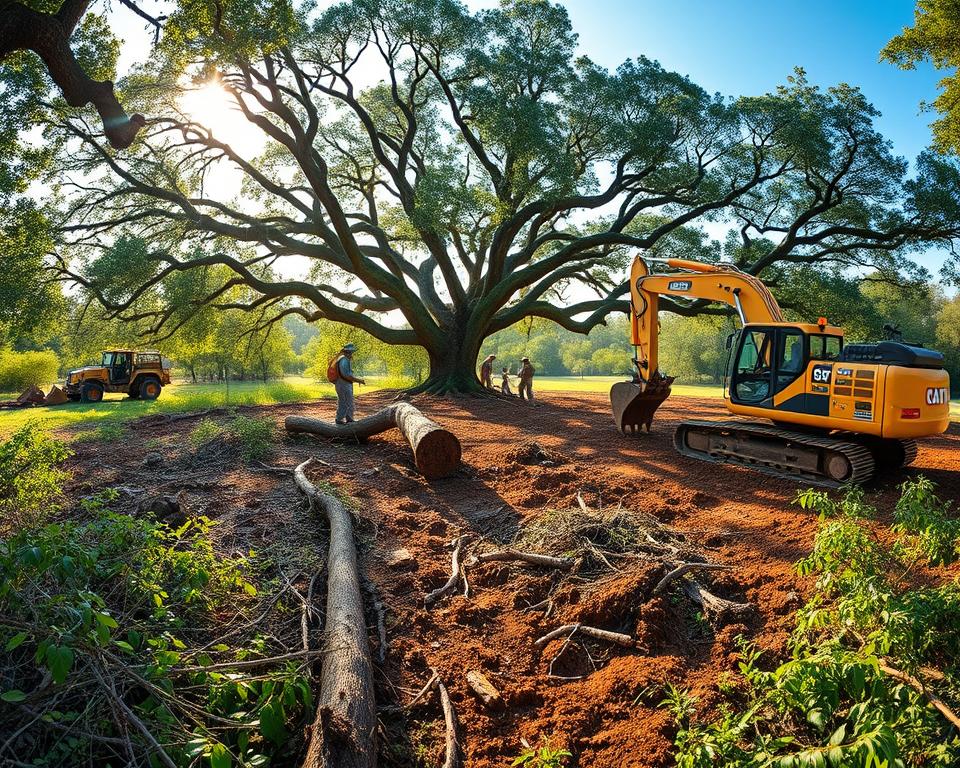Professional Pointers: Forge Paths in Forest Estate
Did you know approximately eighty percent of property owners with woodland grounds seldom venture beyond their lot? That statistic highlights the vital requirement for productive path clearing and upkeep. Clearing paths and footpaths in wooded zones not only improves reachability but also enhances safety and navigation. The following piece will delve into professional methods and perspectives from seasoned trail builders.
These experts will share ways to design well-designed trails that optimize your nature space’s utility while preserving its environmental wholeness. Learn the primary considerations for forestry mulching near me and methods for efficient forest grounds upkeep solutions. Such can render your experience through your outdoor environment more pleasant.
Key Observations
- Comprehending the importance of opening paths for reach and safety.
- Analyzing location attributes to define the purpose of your paths.
- Utilizing the appropriate equipment for efficient path clearing.
- Selecting appropriate ground materials that align with landform.
- Adopting eco-friendly practices when clearing paths.
- Recognizing common mistakes to steer clear of during the trail-clearing process.
Why Clearing Trails in Forested Grounds Matters
Preserving open paths in wooded areas is crucial for several reasons. It significantly improves ease of access, making it easier to traverse thick bushes. Such capability allows property owners and guests to fully enjoy the environment. This clearing also supports different pursuits like hiking, birdwatching, or simply enjoying the outdoors.
Improving Usability
Open trails do more than just facilitate travel; they also strengthen our link with the natural world. By improving access, owners make available the open air to more people. This is useful for individual enjoyment or community events, fostering exploration and valorization of the surroundings.
Promoting Safety and Navigation
The significance of safety on forest paths is paramount. Marked routes offer clear navigation and reduce risks from uneven terrain, concealed barriers, or abrupt plant growth shifts. Landholders invest in establishing secure routes, boosting assurance in wilderness exploration.

Designing Your Forest Path
Effective trail design demands a thorough understanding of the landscape. It is about evaluating ground and site conditions. Understanding the trail’s purpose is also key, as it informs design and maintenance.
Evaluating Terrain and Site Conditions
When assessing ground, several factors are essential. They include:
- Ground compositions that influence water flow and stability
- Incline angle affecting ease of access and security
- Existing vegetation that may need clearing or preservation
By assessing these elements, trails can endure different weather conditions. They also accommodate frequent foot traffic. This approach ensures the path is long-lasting and honors the ground’s original characteristics.
Defining Your Trail’s Purpose
Trail design success relies on a well-defined purpose. Think about the activities the trail will serve, such as:
- Leisurely strolling and outdoor appreciation
- Access for maintenance or land management
- Chances to watch fauna and learning
Understanding the path’s goal guides many decisions. Such understanding includes the path’s width and construction materials. Recognizing the trail’s goal is vital for creating a route that meets its needs.
Essential Equipment for Path Opening
Effective path opening requires the proper gear for different jobs. The appropriate tools increase efficiency and security, simplifying the procedure. The selection between hand tools and power tools varies with the task’s size, ground, and amount of debris.
Fundamental Handheld Tools
Hand tools are key for accuracy and versatility in clearing dense areas. Essential tools include:
- Pruning loppers: Ideal for slicing heavy branches and bushes.
- Handsaws: Perfect for precision cuts on wood limbs.
- Ho-dads: Useful for digging and forming drainage ditches.
Such instruments provide a manual approach, crucial for sensitive areas where machinery could damage.
Power Tools for Productivity
For large-scale path opening projects, power tools are a major advantage. Such equipment make the process speedier and more productive. Crucial equipment include:
- Chainsaws: Perfect for cutting down big trees and slicing dense underbrush.
- Brush-cutters: Quick for clearing thick turf and young shoots.
Motorized tools cuts down opening duration, making it suitable for large areas. Secure operation is critical to avoid injuries.
Approaches for Path and Trail Preparation
Opening paths and trails in wooded grounds requires careful planning. It is vital to mediate functionality with sustainability. Effective plant control maintains the natural ecosystem’s balance while creating useful pathways. This equilibrium is key to a pleasant exterior experience.
Removing Excess Growth
Targeted removal techniques are vital when tackling excess vegetation. Hand tools allow for accurate extraction of undesirable plants without harming the ecosystem. Such approach encourages the growth of preferred plants while restraining foreign species. Ongoing maintenance prevents regrowth, enhancing path security and ease of travel.
Creating a Sustainable Pathway
A sustainable path layout is more than aesthetic; it includes choosing resources that minimize soil loss and enhance water runoff. These methods respect the environment and lessen environmental harm. Using native stones or reclaimed wood supports durable durability and ecological harmony. Thoughtful planning strikes a equilibrium between usability and environmental preservation.
Trail Flooring Choices
Selecting the appropriate path surface is vital for both usability and durability. The choice between organic and artificial surfaces impacts maintenance, user experience, and path lifespan. Knowing the various materials and their fitness for your ground is crucial to creating an optimal route.
Organic versus Synthetic Trail Covers
Natural surfaces, such as gravel, crushed stone, or mulch, are often less costly. They blend well with the surroundings, facilitating water flow and a organic appearance. In contrast, synthetic covers like masonry tiles are more durable and suitable for heavy use. Every option has its advantages and drawbacks, depending the planned use and climate factors.
Selecting Materials per Ground Type
Selecting the right materials involves evaluating ground composition, water requirements, and budget. Here’s a basic guide to common options:
| Material | Advantages | Disadvantages | Cost per Square Foot |
|---|---|---|---|
| Gravel | Inexpensive, Good drainage | Requires regular top-up | $1 – $3 |
| Crushed Stone | Steady footing, Organic appearance | Can be difficult to walk on in wet conditions | $2 – $5 |
| Wood Chips | Eco-friendly, Soft underfoot | Needs frequent topping up | $1 – $2 |
| Concrete Pavers | Durable, Low maintenance | More expensive initially | $5 – $15 |
Carefully choosing trail surface materials guarantees your routes are practical and enhance the site’s natural beauty.
Constructing Elevated Walkways
Establishing trails in wooded grounds requires thoughtful consideration of level shifts. This is key for smooth transitions across various terrains and maintaining trail usability over time. Constructing overpasses for paths is often required, mainly when spanning marshy spots or low-lying ground.
Identifying When to Add Height Variations
Height in trail design is often due to uneven landscapes. Significant level changes necessitate structures like overpasses or raised walkways to maintain trail integrity. This method helps prevent soil erosion and ensures security, vital for both leisure walkers and serious outdoor enthusiasts.
Choosing Bridge Materials for Marshy Terrain
The choice of supplies for elevated walkways and overpasses is critical for their security and longevity. Timber beams, concrete blocks, or treated lumber can provide the necessary strength against weight and weather conditions. It’s crucial to choose supplies that are water-resistant to avoid decay and support subsequent modifications.
Trail Maintenance and Upkeep
Keeping trails secure and accessible requires continuous maintenance. Regular checks assist in identifying issues early, making sure visitors have a positive experience. It’s vital to upkeep paths throughout the year, as climatic shifts can damage them. This section will discuss a comprehensive maintenance checklist and the advantages of employing expert trail maintenance services.
Seasonal Maintenance Checklist
A complete checklist helps trail owners maintain their trails in prime condition all year. Key tasks include:
- Removing obstacles such as fallen branches and leaves.
- Inspecting path layers for wear and tear, following bad weather.
- Checking water channels to avoid flooding.
- Fixing erosion by adding gravel as required.
- Refreshing signage and markers for clear navigation.
Expert Path Care Providers
For those needing professional help, professional trail maintenance services are a excellent option. They offer:
- Thorough path evaluations by skilled professionals.
- Specialized repairs and renewal of high-traffic trails.
- Using specialized equipment for better surface care.
- Applying sustainable methods to prolong trail life.
Hiring professional trail maintenance frees up time for other outdoor pursuits. It also introduces expert skill.
Beautifying Trail Borders
Garden design is crucial to rendering paths attractive. By thoughtfully selecting plants and elements, you can craft an inviting environment. This not only attracts visitors but also supports local ecosystems. The right vegetation for paths provide aesthetic appeal and maintain environmental stability.
Incorporating Flora for Aesthetic Appeal
When designing pathside planting, selecting the right plants is critical. Local species are ideal as they naturally fit in with the surroundings. They need less maintenance and offer homes for local fauna. Combine blooming flora, shrubs, and turf for a varied, attractive setting around trails.
Using Stones and Edging Materials
Border supplies like stones and pavers are vital for path form. They outline the path and add its aesthetic. These materials prevent soil erosion and provide a clean border with vegetation. Using different finishes and colors can render the trail more engaging.
Environmental Considerations in Trail Clearing
Trail opening projects should focus on environmental sustainability. Responsible land management practices help preserve the area’s ecological integrity. This approach ensures paths coexist with nature harmoniously.
Sustainable Practices for Land Management
Embracing sustainable approaches in path clearing is essential. Low-impact methods reduce land degradation and protect ecosystems. Targeted removal and biodegradable supplies reduce damage.
Understanding the ground and vegetation is key. It aids ethical clearing and enhances trail usability.
Impact on Local Wildlife and Flora
Wildlife impact assessments are important in path development. They assist gauge the project’s impact on local animals and flora. This permits for required adjustments before construction begins.
Identifying sensitive species’ habitats prevents environment disruption. This equilibrium guarantees a vibrant environment for every form of life.
Path constructors can design eco-friendly pathways with thoughtful preparation. This commitment to eco-friendly practices and fauna protection enhances outdoor experiences. It balances recreational activities with nature’s respect.
Pitfalls to Avoid in Path Opening
Participating in path clearing demands steering clear of frequent pitfalls to avoid long-term problems. Identifying these mistakes enables for better preparation and execution. By emphasizing simple trail design and addressing water flow, one can prevent extensive upkeep demands.
Over-Complicating the Path Design
Path management often falls into the pitfall of overengineering trail layout. Numerous enthusiasts think elaborate designs make paths more appealing. However, simplicity is often the secret to success. Simple paths enhance wayfinding and upkeep, minimizing obstacles.
Unnecessary twists and intricate elements can lead to path mistakes. These errors complicate utilization and wayfinding, making trails less enjoyable.
Neglecting Water Management
Neglecting drainage issues in trails can have serious outcomes. Adequate drainage planning avoids logging, which can erode paths and damage grounds. Sufficient drainage solutions are essential for a durable trail.
Making sure proper runoff from the path safeguards the pathway and protects the ecosystem. This enables for a more enjoyable outdoor experience.
As a Final Point
Trail clearing is vital for those who desire to fully appreciate their forest properties. It improves accessibility and safety, making exterior areas pleasant for everyone. Woodland paths offer more than mere beauty; they offer chances for leisure and learning about the ecosystem.
Effective design and implementation are crucial in trail clearing. Assessing ground and selecting the right materials are essential for creating durable routes. Regular upkeep ensures these paths safe and open, fostering a ongoing connection with nature.
By understanding the concepts discussed above, you can plan and upkeep trails that serve both functional and leisure needs. Adopting woodland trails can transform your grounds into a sanctuary for exploration, rest, and appreciating nature.
